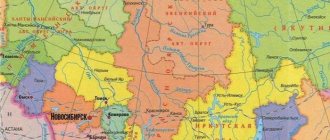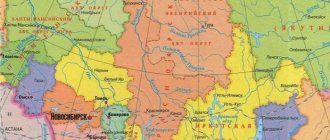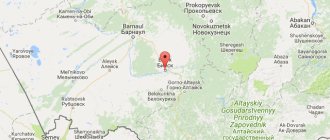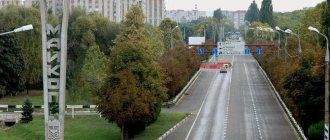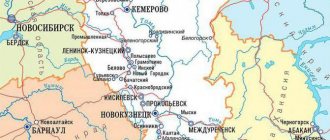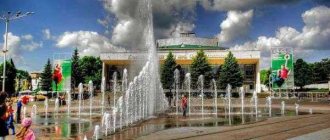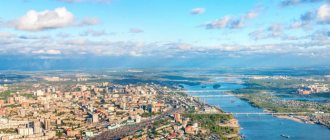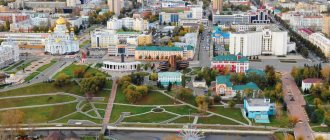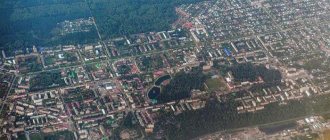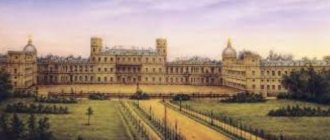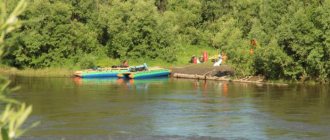Where is Abakan
The city stretches along the bank of the river of the same name, which flows into the Yenisei. The distance to Moscow is 4200 km, to Krasnoyarsk - about 400. The time difference with the capital is four hours. A maternity regime has been introduced in the republic. The city is located in the very center of the Khakass-Minusinsk basin. It is located at an altitude of 250 meters above sea level.
Climate
Where is Abakan located from a meteorological point of view? The city occupies a continental zone, which is characterized by frosty winters and hot summers. The cold period is protracted and characterized by low air temperatures. Spring comes to these parts in mid-April. And winter begins in the second ten days of October. Frosts also occur in June. The hottest month is July. During this period the thermometer reaches 35 °C, the average maximum is 26 °C. This is the rainiest month of the summer.
The least precipitation falls in August. The atmosphere warms up to 32 °C, but usually the thermometer stays at 20 °C. The first autumn frosts are already possible this month. During cold spells, the temperature at night drops below 1 °C. It can still be hot in September. After sunset the air cools to -7 °C. The average daily temperature is 10 °C. There is still little precipitation, the norm is 30 millimeters.
War years
During the Great Patriotic War, approximately 30 thousand soldiers were sent to the front from here. The famous 309th division was formed in Abakan, and it was this division that was able to defend the Ukrainian city of Pyryatyn. This date became memorable for two settlements. Abakan and Piryatin are sister cities.
After the end of the war, light industry enterprises begin to be built, new resources are found, many free jobs appear, and more and more people come to Abakan to work and stay forever. At the same time, construction of one of the largest hydroelectric power stations begins.
Autumn and winter periods
In October there are severe frosts. Night temperatures tend to reach -20 °C. It rains even less. In November, negative values are observed already during the day. The air does not warm up above -5 °C. The volume of precipitation is 10 mm. December brings freezing frosts to the area where Abakan is located. The absolute minimum during this period was -42 °C.
The amount of precipitation that falls in the form of snow gradually increases. January and February are relatively warmer than December. These months are characterized by strong snowstorms that cause snowstorms on the roads. On such days, high-voltage wires break, which leads to interruptions in the power supply.
The average annual air temperature in Abakan is 2 °C, humidity fluctuates around 70%. The average wind speed does not exceed 2.2 meters per second.
Flag
The flag of Abakan is not included in the State Heraldic Register of the Russian Federation due to non-compliance with standards. It has elements contained in the coat of arms. The banner is made in the form of a white rectangular canvas. The ratio of the width and length of the flag is 2:3. There are two vertical stripes of red and blue, each 0.2 conventional units wide (located together at the shaft). One third of the width of the flag is a two-sided image of the coat of arms. Its center is 1.25 conventional units from the left vertical edge and is equidistant from the top and bottom.
Neighbours
Returning to the topic of geographical location, we will first answer the most popular questions. Where is the city of Abakan? In what field? Which country does Khakassia border with? First things first. So, Abakan is located in the Khakass Republic. It is not a region. It was given the status of an autonomous subject of the Russian Federation. It is part of the structural division of the Siberian Federal District. Belongs to Eastern Siberia.
Next to it is the Krasnoyarsk Territory. Among Khakassia's closest neighbors are the Kemerovo region, the Republic of Tyva and the Altai Territory.
Coat of arms
The coat of arms of Abakan is a red heraldic shield, inside of which there are three compositions on a white background, each of which has its own field color: in the upper part there is the inscription “Abakan” in stylized white letters on a red background; in the middle part of the shield on a blue background there are schematic images of three white stone steles with iconic blue drawings of an ancient man; the central stele has a frontal location, the side stelae are turned with patterns towards the central stele. At the bottom of the field, the shield is crossed by two horizontal wavy lines of blue on a white background, reminiscent of sea ripples; in the lower part of the shield, in the center of the light green field, there is a large image of a flower - an orange fry with a border of green petals on a straight, low green stem with two symmetrically located green leaves of different sizes.
Transport accessibility
The easiest way to get to Abakan is by air. Flights from Moscow regularly land at the city airport. To accurately calculate the distance between the capital of the Republic of Khakassia and Moscow, you need to know exactly where the city of Abakan is located, which region or region is located nearby. If you believe the geographical map, then there are about 4200 kilometers between the two settlements.
Airplanes and S7 fly to Abakan from the Russian capital. Travel time is approximately four and a half hours. Ticket prices vary from 5,000 to 30,000 rubles. Thrifty people choose air travel from Moscow to Krasnoyarsk, and then transfer to an intercity bus.
Before you go by train, you need to be aware of where the city of Abakan is located and what region is located nearby. This is very important, because you will spend more than three days on the road.
The price of a ticket for a reserved seat carriage costs approximately 6,000; for a compartment you will have to pay more than 11,000 rubles. A trip from Moscow to Abakan by private car will turn into a real journey. There are no direct flights to St. Petersburg. Passengers from the Northern capital travel with a transfer.
City `s history
01.02.2018
Gallery of historical photographs of Abakan: photographs of V. Azarenkov, photographs from the archive of the Honorary Citizen of the city of Abakan Gennady Vyatkin
In 1675, on Sosnovy Island, at the mouth of the Abakan River, at its confluence with the Yenisei, the first Russian fortress in Khakassia was founded - the Abakan fort. This was the first large state, military-engineering structure on the territory of the future city, recorded in historical documents. From the day of its foundation, the Abakan fort became an administrative center on lands inhabited by “foreigners.” The fort housed the Abakan Administrative Office, the main institution for the administration of the Khakass living in the Minusinsk Basin.
The biography of modern Abakan begins with this fortress. Here, in this fortress, the name “Abakan” was heard for the first time: the Cossack post “Abakan”, the fort “Abakan”.
Ostrog marked the beginning of the process of development of the Minusinsk Basin by the Russians, followed by a number of Russian settlements.
In 1706-1707, Peter I issued three personal Decrees on the construction of a new fort on the Abakan River, and in 1707, the Abakan fort was erected on the Yenisei, 20 versts from the mouth of the Abakan River. 1707 is the year of Khakassia's entry into Russia.
The birth of the city of Abakan is inextricably linked with the process of annexing Khakassia to Russia.
An ancient Khakass aul was located on the hill of Akh Tigei for a long time; with the appearance of Russians there, the aul was given the name Ust-Abakansky. The indigenous people gradually moved from a nomadic life to a sedentary one, began to engage in farming, plowed the nearby lands, and sowed grain crops. The ulus began to grow, and in 1823 on the maps of the Russian Empire it was already listed as a large settlement, the village of Ust-Abakanskoye.
In 1822, in accordance with the Siberian administrative state reform of the management of “foreigners,” the Khakass lands were transformed into 4 Steppe Dumas: Kyzyl, Kachin, Koibal and Sagai, which were included in the Minusinsk district of the Yenisei province. The village of Ust-Abakanskoye becomes the administrative center of the Kachin Steppe Duma (foreign council). It included 11 clans with a total number of “cattle breeders and industrialists” of 8820 souls. The Duma united tribes living in a large area between the Abakan and Iyus rivers. In 1855, the Kachin Steppe Duma was divided into 2 foreign councils: Abakanskaya - with a center in the village of Ust-Abakanskoye and Iyusskaya - with a center in an ulus near Lake Firkal. During this division, 65 uluses were assigned to the Abakan administration, in which 5,788 souls lived.
In 1912, the Abakan Foreign Council was transformed into the Abakan volost and the village of Ust-Abakanskoye became the center of the Abakan volost.
On November 4, 1923, the Presidium of the All-Russian Central Executive Committee of the USSR adopted a decree on the formation of the Khakass district of the Yenisei province. The district was separated into an independent administrative unit and united the territories of former foreign administrations. The village of Ust-Abakanskoye was determined as the district center.
On May 25, 1925, the Resolution on the formation of the Siberian Territory was adopted, Khakasssky district was transformed into a district, which included Askizsky, Bogradsky, Tashtypsky, Charkovsky and Chebakovsky districts. The village of Ust-Abakanskoye becomes the administrative center of the Khakass Okrug. An attempt was made to rename the village to the city of Khakassk, but no official decision was made. In the documents of those years, the village is listed as the city of Khakassk, village. Ust-Abakanskoe, st. Abakan.
In 1930, the Siberian region was divided into two regions: West Siberian with the center in Novosibirsk and East Siberian with the center in Irkutsk. On October 20, 1930, the Khakass Okrug was transformed into the Khakass Autonomous Region, which is part of the West Siberian Territory.” The village of Ust-Abakanskoye becomes a regional center and on April 30, 1931, the village of Ust-Abakanskoye was renamed the city of Abakan. The population at the date of the city's formation was 10.7 thousand people.
After the reorganization of the West Siberian Territory, on December 7, 1934, the Khakass Autonomous Region became part of the Krasnoyarsk Territory.
Until 1991, Abakan was the administrative center of the Khakass Autonomous Region within the Krasnoyarsk Territory. In July 1991, after the region was transformed into a republic, the city of Abakan received the status of the capital of the Republic of Khakassia.
Currently, Abakan has the status of an urban district and is the administrative center of the Republic of Khakassia. The area of the city is 112.4 square meters. km (0.2% of the territory of the republic).
The population as of January 1, 2022 is 181,709 people (33.8% of the population of the republic). The population density of the city is 1617 people per 1 square kilometer.
In April 1981, by decree of the Supreme Soviet of the USSR, the city of Abakan was awarded the Order of the Badge of Honor.
The city of Abakan has its own symbols: coat of arms and flag.
In 1859 in the village. Ust-Abakanskoe had 21 farms with a population of 183 people. According to the All-Russian Agricultural Census of 1917 in the village. There were 116 farms in Ust-Abakanskoe, in which 539 people lived.
According to N.F. Katanov, in 1859 Ust-Abakansk consisted of 21 courtyards. The only “cultural center” was the Orthodox Church. In 1863, an elementary school of the Russian Ministry of Education was opened in Ust-Abakansk. There were 12 students at the school - boys. The first school building had a study room, a library, a dormitory for children and a teacher's apartment.
In 1906, Ust-Abakansk had its own industry, which was represented by the tannery of the Minusinsk tradesman Monastyrshin. The plant produced 700 pieces of different leathers per year with one worker.
In 1913 Ust-Abakanskoye becomes the center of the Ust-Abakan volost. The new part of the city begins to develop with the construction of the Achinsk-Minusinsk railway. Construction began in 1914, from this period the history of the village of Abakan begins. But the First World War stopped the construction of the railway.
During this period, near the young village of Abakan there were 3 Khakass aalas: Atknino, Okunevo, Badyan Katykh. On the site of today's Orlyonok Park there was a lake called Igar oba kol (Crooked Lake), where local residents hunted waterfowl.
In the 20s, construction of the Achinsk-Minusinsk railway began. On November 23, 1925, the grand opening of the Abakan station took place. The Achinsk-Abakan railway line, 459 kilometers long, was put into permanent operation.
In 1926, in the new part of the city near the station there were two streets: Vokzalnaya and First Street (Pushkina).
In 1928, the first two-story building for railway workers appeared in the city, then a club.
By 1929, there were already 9 streets in the city - up to Chertygashev Street. The Khakass Pedagogical College opens. In the same year, the Abakan Museum opened, its first director was V.A. Ryumin.
Already in the late 20s, the question of transforming the village of Ust-Abakanskoye into a city began to be raised. On the eve of the transformation of the village of Ust-Abakanskoye into a city, 10,665 people lived here. On October 20, 1930, a decision was made to form the Khakass Autonomous Region. And on April 30, 1931, the village of Ust-Abakanskoye was renamed the city of Abakan, the center of the Khakass Autonomous Region.
In 1931, there were 3 schools in the city: at the kirzavod, a school for 436 people and a factory school at the railway, 2 traveling doctors, a telephone exchange with 3 numbers. There were 3 newspapers published in the city: Sovetskaya Khakassia, Khyzyl Aal, Komsomol of Khakassia.
On June 9, 1931, the city limits were approved; they were established from the railway bridge along the Abakan River to the agricultural boundaries and to the Yenisei River. From the railway bridge to Bulun Island.
In 1932, there were already several industrial enterprises: these were the cooperatives of the disabled, the Sewing Worker, the fur and tannery, the confectionery factory and the collective farms Sila and Krasny Abakan.
In 1933, on the initiative of Komsomol members of the city of Abakan, “Crooked Lake” was drained and a park was founded (now the “Orlyonok” children’s park). In the same year, the Palace of Culture was founded, which was opened in 1936.
During 1932-1933. A meat processing plant, a furniture factory, a locomotive depot, and a power plant were built in the city.
In 1934, the first enrollment was made at the Abakan Medical School.
In 1939, there were 12 schools, 8 kindergartens, a pedagogical school, a veterinary school, a paramedic and midwifery school, 11 canteens, etc. in Abakan.
In 1939-1944. There is a puppet theater in the city.
During the Great Patriotic War, the city lived and developed. Several hospitals and evacuated enterprises were located here. The population is growing. In 1946, a confectionery factory and sokovin began operating, in 1950 - a textile factory, in 1950-1951 400 individual residential buildings were built, in 1951 the building of the Pobeda cinema was commissioned.
During the construction of the Abakan-Taishet railway, large construction organizations were created in the city, such as the Abakanpromzhilstroy trust, Abakantselinstroy, construction departments Khakasvodstroy, Remstroytrest, etc. In the 60s, a bakery plant was built in Abakan (1963), a knitwear (1967) and then a shoe (1969) factory was put into operation, the first facilities of the Abakan cargo river port were launched (1967), etc.
In the period 1972-1985. a panel house-building plant, a building materials plant for rural builders, an expanded clay gravel plant, an experimental mechanical repair plant, etc. were built.
In April 1981, by decree of the Supreme Soviet of the USSR, the city of Abakan was awarded the Order of the Badge of Honor.
In 1982-1985, Abakan occupied a leading position in Russia in terms of development rates.
During these years, the city was also developing due to the construction of Abakanvagonmash. The first capacities of the carriage plant were commissioned in December 1975, and the first capacities of the container plant were commissioned in 1981. During these years, residential microdistricts of the city were formed.
Famous scientists, including Professor L.R. Kyzlasov, studied the ancient and medieval settlements of Southern Siberia. His book “Written News of the Ancient Cities of Siberia” is devoted to the study of ancient cities based on excavations. P.I. Karolkin and V.M. Torosov studied the history of the city.
Demographics
Population in 1917
| Number of farms | Population, people | Including | ||
| men | women | |||
| Ust-Abakan volost | 1693 | 10135 | 5111 | 5024 |
| from her: | ||||
| With. Ust-Abakanskoe | 116 | 539 | 265 | 274 |
| of them: assigned to society | 59 | 293 | 129 | 164 |
| outsiders | 57 | 246 | 136 | 110 |
In 1926, the population of the village. Ust-Abakanskoe was 1.5 thousand people, over 10 years (from 1920 to 1930) the population increased by a thousand people on average per year and at the beginning of 1931 reached 7.7 thousand people. According to the All-Russian Population Census in 1939, 36.7 thousand people lived in Abakan; compared to 1917, the city’s population increased 68 times.
During the war years, the city's population increased due to evacuated residents; in 1943-1944. it was about 44 thousand people. During the war, 6 base evacuated hospitals with wounded servicemen were located in Abakan.
According to the All-Russian Population Census of 1959, the population of Abakan was 56.4 thousand people. The share of the population of Abakan in the total population of the Khakass Autonomous Region was 13.7%.
Population dynamics of the city of Abakan (at the beginning of the year, thousand people)
| 1931 | 1932 | 1933 | 1935 | 1939 | 1950 | 1956 | 1959 |
| 7,7 | 12,3 | 13,7 | 14,9 | 36,7 | 37,7 | 48,4 | 56,4 |
Population
1) (at the beginning of the year; people)
| Years | Total | including | |
| men | women | ||
| 1939 | 36652 | 18339 | 18313 |
| 1959 | 56416 | 25287 | 31129 |
| 1979 | 129404 | 61322 | 68082 |
| 1989 | 152998 | 71049 | 81949 |
| 1990 | 155224 | 75869 | 79355 |
| 1991 | 155629 | 75854 | 79775 |
| 1992 | 156241 | 75913 | 80328 |
| 1993 | 156388 | 75826 | 80562 |
| 1994 | 157283 | 76053 | 81230 |
| 1995 | 159447 | 76647 | 82800 |
| 1996 | 161082 | 76966 | 84116 |
| 1997 | 162378 | 77257 | 85121 |
| 1998 | 163277 | 77406 | 85871 |
| 1999 | 164392 | 77607 | 86785 |
| 2000 | 164655 | 77374 | 87281 |
| 2001 | 166747 | 76334 | 90413 |
| 2002 | 166274 | 77097 | 89177 |
| 2003 | 165189 | 76209 | 88980 |
| 2004 | 164899 | 76272 | 88627 |
| 2005 | 164695 | 76024 | 88671 |
| 2006 | 164384 | 75797 | 88587 |
| 2007 | 163591 | 75399 | 88192 |
| 2008 | 163803 | 75485 | 88318 |
| 2009 | 164121 | 75661 | 88460 |
| 2010 | 164560 | 75785 | 88775 |
| 2011 | 165770 | 75993 | 89777 |
| 2012 | 167562 | 76608 | 90954 |
| 2013 | 169760 | 77496 | 92264 |
| 2014 | 173205 | 78894 | 94311 |
| 2015 | 176212 | 80068 | 96144 |
| 2016 | 179163 | 81446 | 97717 |
| 2017 | 181709 | 82412 | 99290 |
1) The data is given: 1959 – according to the population census as of January 15; 1979 – according to the census as of January 17; 1989 – according to the census as of January 12; for other years - assessment as of January 1 of the corresponding year, for 1990-2001. – taking into account the results of the 2002 population census, for 2003-2009. – taking into account the results of the 2010 population census.
Basic demographic indicators (people)
| Years | Born | Dead | Natural increase, decrease (-) | Migration increase, decrease (-) |
| 1931 | 469 | 193 | 276 | 2773 |
| 1959 | 1254 | 441 | 813 | |
| 1990 | 2260 | 1774 | 486 | 1130 |
| 1991 | 2062 | 1749 | 313 | 988 |
| 1992 | 1783 | 1927 | -144 | 170 |
| 1993 | 1706 | 2258 | -552 | 1469 |
| 1994 | 1738 | 2560 | -822 | 2611 |
| 1995 | 1687 | 2291 | -604 | 2785 |
| 1996 | 1598 | 2177 | -579 | 2486 |
| 1997 | 1535 | 2095 | -560 | 2713 |
| 1998 | 1571 | 2225 | -654 | 2091 |
| 1999 | 1518 | 2336 | -818 | 1011 |
| 2000 | 1701 | 2225 | -524 | 736 |
| 2001 | 1695 | 2292 | -597 | 127 |
| 2002 | 1885 | 2487 | -602 | -375 |
| 2003 | 1951 | 2491 | -540 | -77 |
| 2004 | 1974 | 2334 | -360 | 361 |
| 2005 | 1889 | 2518 | -629 | -65 |
| 2006 | 2029 | 2088 | -59 | -818 |
| 2007 | 2080 | 1918 | 162 | -76 |
| 2008 | 2272 | 1953 | 319 | -146 |
| 2009 | 2403 | 1949 | 454 | -199 |
| 2010 | 2398 | 1902 | 496 | 456 |
| 2011 | 2436 | 1853 | 583 | 1209 |
| 2012 | 2508 | 2042 | 466 | 1732 |
| 2013 | 2637 | 1944 | 693 | 2752 |
| 2014 | 2595 | 1984 | 611 | 2396 |
| 2015 | 2733 | 2055 | 678 | 2273 |
| 2016 | 2619 | 2001 | 618 | 1928 |
Basic demographic indicators (per 1000 population)
| Years | Born | Dead | Natural increase, decrease (-) | Migration increase, decrease (-) |
| 1931 | 38,1 | 15,7 | 22,4 | |
| 1959 | 22,2 | 7,8 | 14,4 | |
| 1990 | 14,4 | 11,3 | 3,1 | 7,2 |
| 1991 | 13,1 | 11,1 | 2,0 | 6,2 |
| 1992 | 11,3 | 12,2 | -0,9 | 1,0 |
| 1993 | 10,7 | 14,2 | -3,5 | 9,2 |
| 1994 | 10,9 | 16,0 | -5,1 | 16,3 |
| 1995 | 10,4 | 14,1 | -3,7 | 17,2 |
| 1996 | 9,7 | 13,3 | -3,6 | 15,1 |
| 1997 | 9,2 | 12,6 | -3,4 | 16,3 |
| 1998 | 9,3 | 13,2 | -3,9 | 12,4 |
| 1999 | 9,0 | 13,8 | -4,8 | 6,0 |
| 2000 | 10,1 | 13,2 | -3,1 | 4,4 |
| 2001 | 10,0 | 13,6 | -3,6 | 0,7 |
| 2002 | 11,4 | 15,0 | -3,6 | -2,3 |
| 2003 | 11,8 | 15,1 | -3,3 | -0,5 |
| 2004 | 12,0 | 14,2 | -2,2 | 2,2 |
| 2005 | 11,5 | 15,3 | -3,8 | -0,4 |
| 2006 | 12,4 | 12,8 | -0,4 | -5,0 |
| 2007 | 12,7 | 11,8 | 0,9 | -0,4 |
| 2008 | 13,9 | 12,0 | 1,9 | -0,9 |
| 2009 | 14,7 | 11,9 | 2,8 | -1,3 |
| 2010 | 14,5 | 11,5 | 3,0 | 2,8 |
| 2011 | 14,6 | 11,1 | 3,5 | 7,2 |
| 2012 | 14,9 | 12,1 | 2,8 | 10,3 |
| 2013 | 15,4 | 11,3 | 4,1 | 16,0 |
| 2014 | 14,9 | 11,4 | 3,5 | 13,7 |
| 2015 | 15,4 | 11,6 | 3,8 | 12,8 |
| 2016 | 14,5 | 11,1 | 3,4 | 10,7 |
Information taken from the statistical collection “Chronicle of Siberian Cities. Abakan - 85 years”, published in 2022 by the Office of the Federal State Statistics Service for the Krasnoyarsk Territory, the Republic of Khakassia and the Republic of Tyva (Krasnoyarskstat)
Ecology
The abundance of large industrial enterprises has a negative impact on the environment. Where the city of Abakan (Russia) is located, there are about ten chemical plants. Their emissions, which were measured in 2009, exceeded 43,000 tons. Experts claim that their volume has increased by thirty percent. Toxic formaldehyde gets into the air that city residents breathe. The concentration of other suspended substances exceeded the permissible value three times.
The only worse situation with the environment is in the neighboring city of Sayanogorsk. It produces aluminum. As for the soil, the soil in Abakan and its surroundings is saturated with lead. Scientists predict global mercury pollution in the capital of Khakassia. As a result, the number of people with neoplasms increases every year. About fifteen percent of Abakan residents die from cancer. In the region, for every thousand people there are thirty cancer patients.
The incidence rate in young children is no less high. Abakan closes the top three. This sad rating is headed by Sayanogorsk and Chernogorsk. Every third child in Khakassia suffers from a chronic disease. As a teenager, he already has a whole bunch of serious diagnoses.
Abakan sights
The city is filled with interesting places that are loved by both locals and visitors. Here are some of them:
— guests entering the territory of Abakan are greeted by the stele “Lora” - a Khakassia woman with her hands raised in a welcoming gesture.
— you can walk through the architectural and park complex “The Good Angel of the World”, which is a system of alleys and paths leading to the column where the good “angel” is looking up into the blue heights;
— you should definitely visit the topiary art park. The place is truly unique, because its creator, Vasily Antropov, acquired a patent for the technology used to create stunning works of floral art. There are skillfully trimmed trees and shrubs, flower arrangements, and rare plant species here;
— you should definitely visit the local zoo, which arose in the early 70s as a corner of wildlife. Initially, entry to the zoo was free. The inhabitants of the living area received rations from the meat processing plant (the animals were fed with waste from the production of the enterprise). Since 1999, the zoological park has been under the wing and protection of the state and takes care of more than 150 species of animals;
— coming to Abakan and not visiting the National Museum of the Republic of Khakassia is an unforgivable mistake! An amazing collection of 140,000 exhibits will captivate guests' attention for a long time. The exhibition is based on samples of ancient art and everyday life: ritual masks, dishes, weapons, jewelry... Temporary exhibitions are also open on the territory of the museum, the schedule of which can be found on the official website of the museum;
— you can stroll through the builders’ park, which opened relatively recently, in 2022. A modern fountain, beautiful flower beds with bright flowers, entertaining sculptural compositions with the “Garden City” at the head - there is something to admire here;
— Abakan’s green parks, of which there are many in the city, will be a wonderful place for walks: “Komsomolsky”, “Preobrazhensky”, “Orlyonok”, “Dream Gardens” and other corners of well-tended nature welcome guests every day;
— you can honor the memory of the Khakassian and Russian soldiers who fell in the Second World War by visiting the Military Glory Memorial. Built in the mid-70s, the complex is still a place especially revered by the people;
— the Transfiguration Cathedral is of great interest to tourists. The cathedral does not have a centuries-old history, as it was built at the end of the 20th century. However, the cultural and architectural significance of the temple is impressive. The cathedral is decorated with seven domes (domes), twelve bells, including a handsome one weighing 5.5 tons. The temple stretches up almost 50 meters!
- another religious building that attracts the attention of tourists - the Grado-Abakan Church in honor of Equal-to-the-Apostles Constantine and Helen. The temple was erected on a once neglected and deserted corner of the earth. Construction of the shrine began in 1998 and ended in 2010. The façade of the building is of particular interest: it is masterfully painted “in chess” - an ancient way that imitates and emphasizes architectural details. The list is far from complete; the article lists the most popular places to visit.
